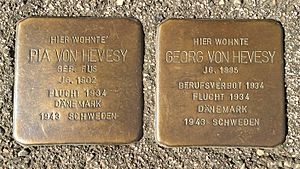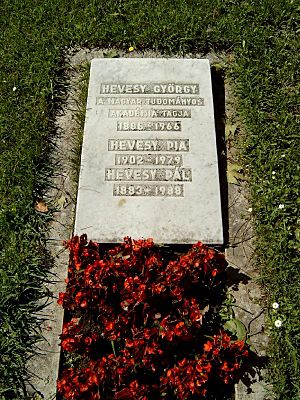George de Hevesy facts for kids
Quick facts for kids
George de Hevesy
|
|
|---|---|
 |
|
| Born |
György Bischitz
1 August 1885 |
| Died | 5 July 1966 (aged 80) |
| Citizenship |
|
| Alma mater | University of Freiburg |
| Known for |
|
| Spouse(s) |
Pia Riis
(m. 1924) |
| Children | 4 |
| Parents |
|
| Awards | Nobel Prize for Chemistry (1943) Copley Medal (1949) Faraday Lectureship Prize (1950) Atoms for Peace Award (1958) Fellow of the Royal Society |
| Scientific career | |
| Fields | Chemistry |
| Institutions | Ghent University University of Budapest Niels Bohr Institute ETH Zürich University of Freiburg University of Manchester Stefan Meyer Institute for Subatomic Physics |
| Doctoral advisor | Georg Franz Julius Meyer |
| Other academic advisors | Fritz Haber Ernest Rutherford |
| Doctoral students | Rolf Hosemann Johann Böhm |
| Other notable students | Erika Cremer (postdoc) |
George Charles de Hevesy (born György Bischitz; 1 August 1885 – 5 July 1966) was a famous Hungarian chemist. He won the Nobel Prize in Chemistry in 1943. Hevesy was honored for his important work with radioactive tracers. These tracers help scientists study how chemicals move in living things, like animals. He also helped discover a new element called hafnium.
Contents
Biography
Early Life and Education
George de Hevesy was born in Budapest, Hungary, in 1885. His family was wealthy and well-known. He was the fifth of eight children.
He started studying chemistry at the University of Budapest. Later, he moved to the University of Freiburg in Germany. He earned his Ph.D. in physics in 1908. After that, he worked with famous scientists like Ernest Rutherford in England. He also met Niels Bohr, another very important scientist. In 1918, he became a professor in Budapest.
Discovering Hafnium
In 1922, George de Hevesy and Dirk Coster discovered a new element. They named it hafnium (Hf). The name comes from "Hafnia," which is the Latin name for Copenhagen. Copenhagen was where Niels Bohr lived and worked.
Scientists knew that an element with 72 protons was missing from the periodic table. Hevesy used Bohr's ideas about atoms to look for it. They found the new element in a mineral sample from Norway. They used special X-ray tests to confirm it.
Pioneering Radioactive Tracers
Hevesy did groundbreaking work using radioactive isotopes. These are like special tags that scientists can follow. He used them to study how plants and animals use chemicals. For example, he could see how plants absorbed nutrients from the soil.
In 1923, he published his first study on this method. He used a radioactive form of lead to track how broad beans absorbed and moved chemicals. This work was very important. It later earned him the Nobel Prize in Chemistry in 1943.
He also developed a method called X-ray fluorescence. This helps scientists analyze materials. In 1936, he invented Neutron activation analysis. This is another way to find out what elements are in a sample.
Later Career and Recognition
After working in Copenhagen, Hevesy returned to Freiburg as a professor. In 1934, he went back to Copenhagen to work with Niels Bohr again.
In 1949, he became a professor at the University of Ghent. Even after he retired, he continued to be an active scientist. He worked at the University of Stockholm.
World War II and Beyond
During World War II, two scientists, Max von Laue and James Franck, sent their gold Nobel Prize medals to Denmark. They wanted to keep them safe from the Nazis. It was against the law to send gold out of Germany.
George de Hevesy came up with a clever plan. He dissolved the gold medals in a strong acid called aqua regia. He then put the liquid on a shelf in his lab. After the war, he found the solution untouched. He was able to get the gold back out of the acid. The Nobel Society then used this gold to make new medals for the scientists.
By 1943, it was not safe for Jewish scientists in Copenhagen. So, de Hevesy moved to Sweden, which was neutral during the war. He worked at the University of Stockholm until 1961. While in Stockholm, he received his Nobel Prize.
Hevesy also received the Copley Medal. He was very proud of this award. He said that while many people get Nobel Prizes, fewer get the Copley Medal.
Family Life and Legacy
George de Hevesy married Pia Riis in 1924. They had four children together. He passed away in 1966 at the age of 80. He was first buried in Freiburg. In 2000, his body was moved to the Kerepesi Cemetery in Budapest, Hungary.
Hevesy wrote almost 400 scientific papers. His work greatly advanced the field of radiochemistry. In 2005, a laboratory was named after him in Denmark. It is called the Hevesy Laboratory. This honors him as the "father of the isotope tracer principle."
See also
 In Spanish: George Hevesy para niños
In Spanish: George Hevesy para niños
- August Krogh
- List of Jewish Nobel laureates
- Johanna Bischitz de Heves
- 10444 de Hevesy
- Hevesy (crater)
- The Martians (scientists)



